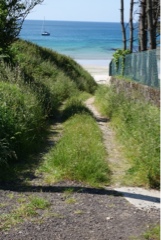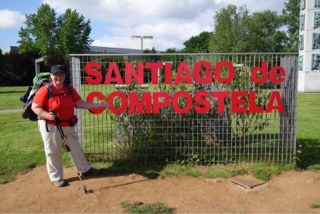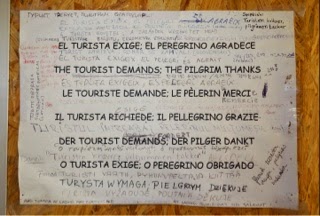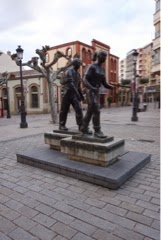Path marker
Finisterre (or Fisterra, in Gallego) is a lovely fishing village on the Atlantic coast of Spain. Before Columbus 'sailed the ocean blue' Europeans thought the westernmost outcropping of rocks here was the end of the earth. Many modern pilgrims choose to walk on to this destination for several reasons:
1. It's hard to stop. You get into a routine of walking, and Santiago feels in some ways like just another city. The road goes on. So those who want/need a more visual or visceral 'end' continue until they really can't go any further west.
2. One needs better closure. For many pilgrims who walk a long distance, the last 100km and Santiago are more crowded and commercial than the previous parts of the walk. One former pilgrim warned us about this. He explained that, in a way, it is preparing us for re-entry to the busy-ness and commercialism of the world we live in. But fewer people make the walk to the ocean. So, for those who would like to have some peace & quiet to process their experience a bit, have a few more days of walking in solitude, and have some time to think/write/etc, the walk to Finisterre and time in the village provides the opportunity to do so.
3. They say the Celts did it. Before Christians 'found' the remains of James & 'created' the pilgrimage we now have, it is believed that some of the Celts made a journey of a similar nature, following on the earth what they believed to be the pathway of the stars. Their journey led all the way to the ocean, which pointed, for them, to Something bigger and more powerful than humans. A lot of 'spiritual but not religious' pilgrims continue for this reason.
I'm sure there are more reasons, but these are the ones we heard cited most often.
Who would have thought when we began that I would want to keep going after Santiago?!? Kirsten had expressed an interest in making this part of the journey since we began planning. I had always assumed I would take the bus and have a few days at the seaside while she made her way here. After we hopped on our hay wagon and got going again, things changed a bit. In part, I (and my feet!) got more accustomed to the daily walking. Because we'd been walking for weeks, and since we knew we had plenty of time, we were less worried about how far we went each day. That meant we were able to go at a pace my body could better handle. It was fewer kilometers per day than before, and it made a huge difference. As we neared the last 100km, I started to realize there was enough time for me to walk to Finisterre, too. And I was surprised to find I wanted to!
As we neared Santiago, the last three days were hard ones for me. Three days out I fell down. Nothing dramatic. I had scaled mountains, crossed rivers, and come down some crazy steep rocky paths. But a piece of loose gravel in the road tripped me up and I was down. Kirsten helped me up, but it was frustrating to say the least. Then, the next day I fell again! A wayward tree root was my nemesis this time. Again, I was fine. Just a few bruises. But it dented the sense of confidence and accomplishment which had been steadily growing on the trail in the end. Partly to get my mojo back, I decided to walk on to the sea. And we decided to walk each at our own pace - meeting up in Finisterre. Kirsten wanted to see what she was capable of after our long journey to Santiago, and so did I.
Turns out we both learned some things. I got back some of my confidence. Kirsten was able to go further faster, but found that it was harder on her body than she had hoped. Both of us discovered we prefer traveling with someone to walking alone. We both met some interesting people and saw the sights, but we found we appreciated having someone to talk with at the end of the day about all we'd seen and done. It also turned out to be beneficial. On the way into the town of Cee, the last place to stay before Finisterre, Kirsten discovered that the last few kilometers were very challenging - steeply downhill and quite rocky. Happily, she shared that information with me - thanks to free wifi! Since I was still bruised from the falls before Santiago, I decided to be smart rather than stubborn and did not walk those 10 kilometers. Instead I took a taxi. This meant (a) I wouldn't mess up my knees or fall again, & (b) I was able to catch up to Kirsten and we walked the next day into Finisterre together.
Finisterre is a lovely place, and the ocean views as you approach are simply amazing. It is traditional for pilgrims who make the walk here to watch the sunset by the lighthouse. Keep in mind that the sun isn't really setting here right now till about 10:00pm. So we decided to spend more than one night here. The first night we went to pick up our credential to show we had done this part of the Camino, walked around the town, and then went out for a delicious seafood feast. The next day we slept in - so very welcome after all this walking! Then we purchased some provisions at the store, packed up a backpack and began the 3 kilometer walk out to the lighthouse at the end of the world.
We spent the afternoon and evening exploring the point, having a picnic, drinking some cava to celebrate and watching the sunset with other pilgrims.
We met some folks who were out for the day with family, chatted with a group of international exchange students who were there on a field trip, and even saw a couple having wedding pictures taken! It was a fun night.
Some pics from the lighthouse...
But what we noticed more was the beauty of the rocks, the mountains, the ocean, the sky...and on this eve of Pentecost, the power of the wind! All of this - everything we could feel, see, hear, smell - was so much more glorious than anything we saw in a church or cathedral. God truly does it better than we humans ever could. This place, this evening, felt much more like 'the end' of the walk to us than had Santiago. As the sun dropped below the Atlantic, we were both a little teary-eyed remembering how far we had come (physically and otherwise!) in the last 40-some days.
As we said our farewell to the sun, we stood up and turned around, only to find that the mountains behind us were bathed in the lavender light of twilight. The scene literally stopped us in our tracks. Then, as we began our walk toward town, the lighthouse beacon began to shine. It was certainly hard to leave this spot.
Our time here at 'the end of the world' helped underscore the beauty we have seen across this country. In the landscapes and the people. It gave us space and time to look back over the weeks of walking, to remember moments both silly and poignant. We had some hard days and there were tears along the way. But we learned new things each day, met interesting people from around the world and laughed harder than either of us has in months - maybe longer. Our pilgrimage was cathartic, and empowering, and humbling, and so much more. Then, we found at the end of the world there is still more. There is joy and light and stunning beauty and a pervasive feeling of hope for what is yet to be.
Yes, for us this was the end in many ways. However, we both wanted to walk on. So after a day of rest we began one last walk to the sea...





















































